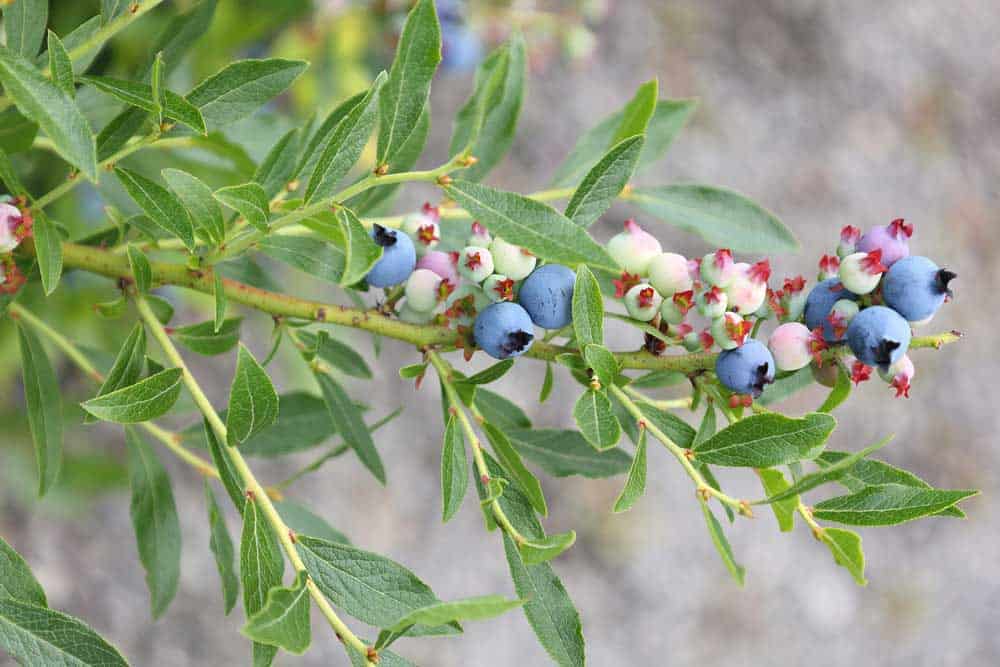Keystone Shrub with Fruit and Biodiversity Benefits

Lowbush blueberry, scientifically known as Vaccinium angustifolium, is a species of blueberry native to the north-central and eastern portions of North America. It is widely appreciated not only for its delicious berries but also for its ecological value and aesthetic appeal in garden and landscape settings. It is considered a keystone plant species by ecological gardeners, a status backed up by Doug Tallamy’s research, which shows that 276 caterpillar species use it as a host plant, and that 6 specialist bee species depend on it.
Growth and Cultivation
Lowbush blueberry is a perennial deciduous shrub that typically grows 5-25 inches tall. It thrives in acidic, well-drained soils, preferably with a pH between 4.5 and 5.5. The plant is adapted to cold climates and can survive in USDA hardiness zones 2 through 6. It requires full sun to partial shade, with at least half a day of sunlight to produce the best fruit yields.
Garden and Landscape Use
In a garden or home landscape, lowbush blueberry can be used as ground cover or as part of a mixed border. It is particularly noted for its fiery red fall foliage and the white to pinkish flowers that bloom in spring. The plant’s compact size makes it suitable for smaller gardens or spaces where low-growing, spreading plants are desired.
Ecological Contributions
Lowbush blueberry plays a significant role in its native ecosystems. It supports a wide range of pollinators, including over 120 native bee species in Maine alone. The flowers provide nectar and pollen that are crucial for these insects, particularly in early spring when other food sources are scarce. Birds and other wildlife also benefit from lowbush blueberry. The berries are a food source for various bird species, including the American Robin, which helps in seed dispersal and plant propagation. The dense foliage offers shelter and nesting sites for small animals and birds.
Pollination and Fruit Production
Pollination is vital for fruit set in lowbush blueberries. Both native bees and commercially managed bees contribute to pollination, with studies showing that native bee activity density can predict the proportion of fruit set in fields. For gardeners, encouraging or introducing native bees can enhance fruit production and support local biodiversity.
Soil and Water Needs
Lowbush blueberry benefits from soil rich in organic matter and consistent moisture. However, it has some drought tolerance once established, making it suitable for regions with occasional dry spells. The use of biochar has been studied for its potential to improve water retention in sandy soils where lowbush blueberry is commonly found.
Visual Interest and Blooming Period
The aesthetic appeal of lowbush blueberry extends throughout its growing season. The plant blooms typically in late spring, around May, depending on the local climate. The blooming period can last several weeks, during which the plants are covered in small, bell-shaped flowers that add significant visual interest to the landscape.
Best Practices for Growing
To grow lowbush blueberry effectively:
- Soil Preparation: Amend the planting area with peat moss or a similar acidic organic material to achieve the desired soil pH.
- Watering: Keep the soil consistently moist but not waterlogged. Mulching can help retain soil moisture and suppress weeds.
- Pruning: Prune plants every 2-3 years to remove older, less productive stems and encourage vigorous new growth.
Lowbush blueberry is a versatile and valuable plant for both ecological and aesthetic purposes in a garden setting. Its ability to support a wide range of wildlife, coupled with its attractive appearance and delicious fruits, makes it a desirable choice for gardeners looking to create a sustainable and productive landscape.
Header Image: “Lowbush Blueberry (Vaccinium angustifolium) – St. John’s, Newfoundland 2019-08-08” by Ryan Hodnett is licensed under CC BY-SA 4.0.
